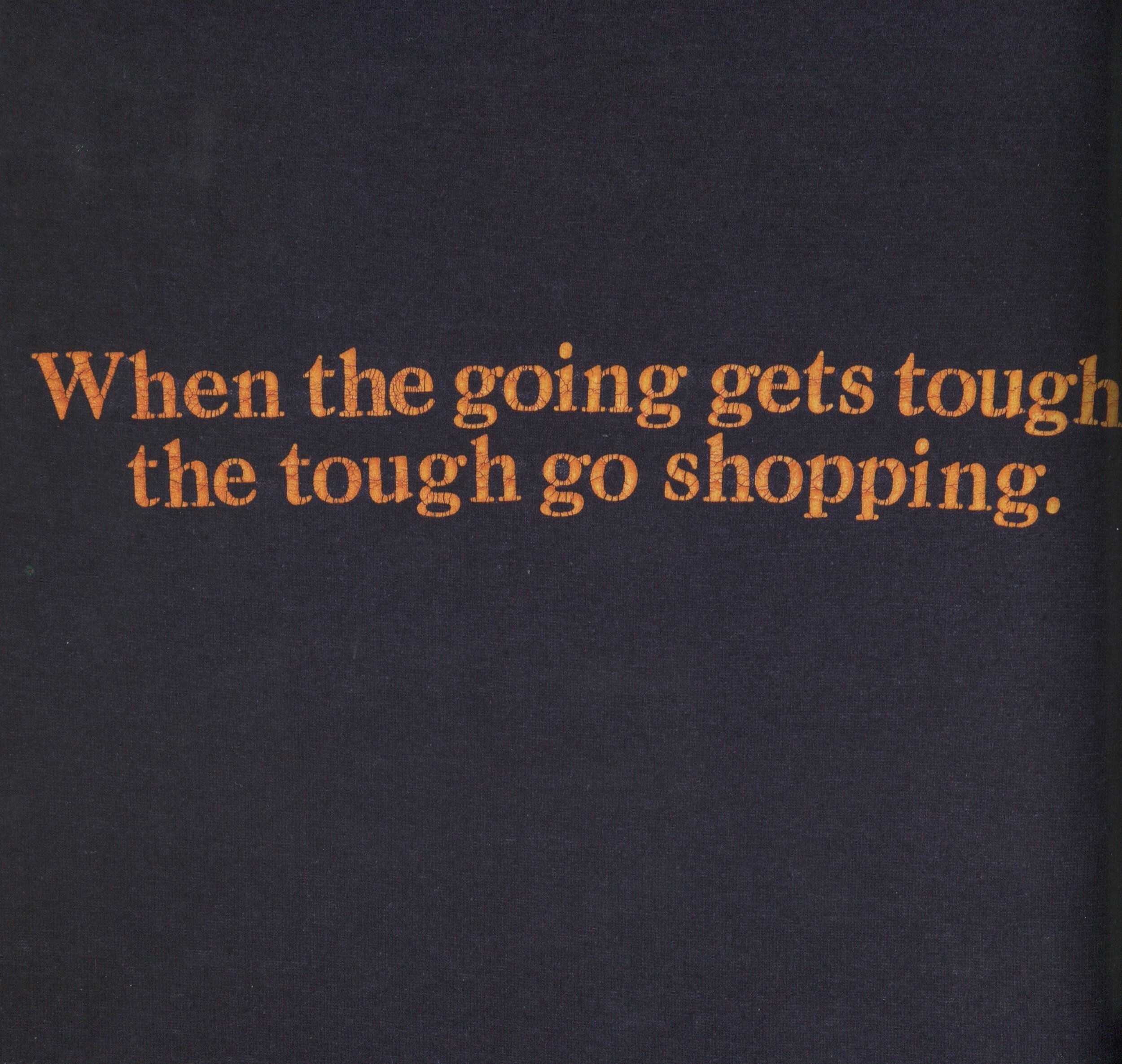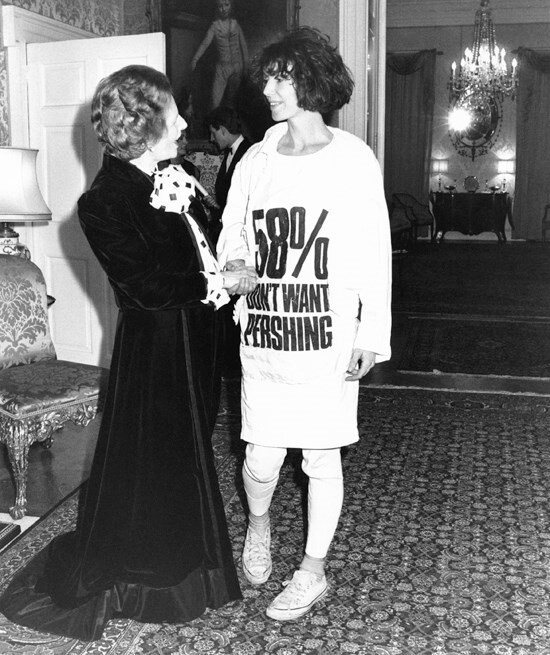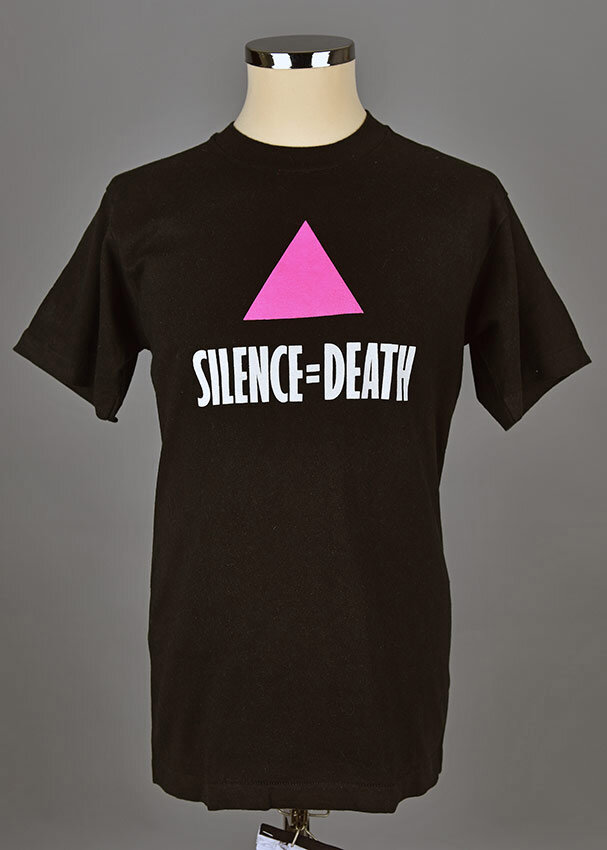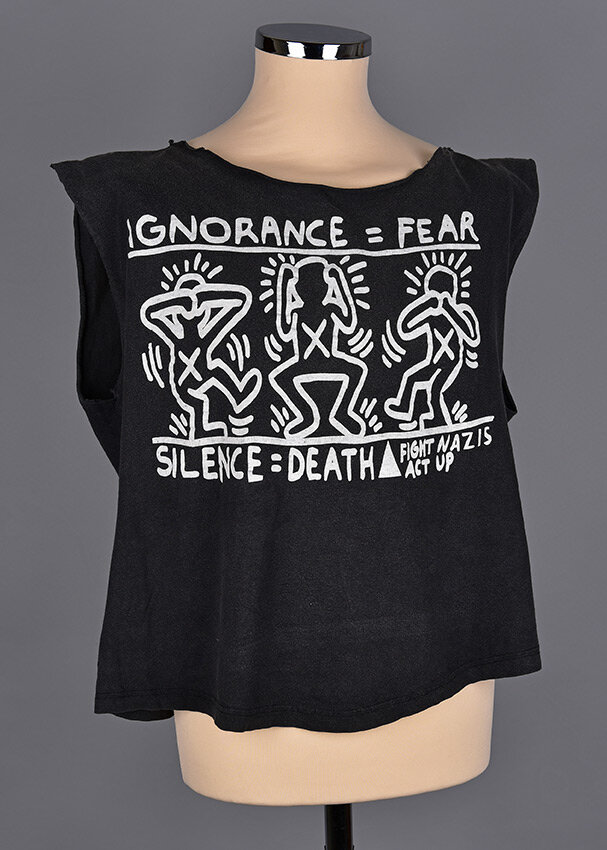
The 1980s
The 1980s are often remembered for its bright aesthetics, electronically infused music and for an emphasis on mass consumerism. Shopping malls became the central hub of American social life across the country, a gathering place to spend time with friends and indulge in the latest styles and trends.
Through the thick fog of hairspray and forest of acid wash denim, political unrest continued to poke through. The protest T-shirt would enter it’s most influential stage in the 1980s, gaining worldwide exposure as it was utilized in the world of global politics.
Background: ACT UP demonstrators protesting outside the headquarters of the Food and Drug Administration in Rockville, Md., on Oct. 11, 1988.
Slogan T-shirt from the 1980s, exemplifying the attitude of many that emphasized the importance of consumer goods.
Ronald Reagan’s win in the 1980 presidential election solidified the end of a dying free love movement. Free enterprise was now able to take centre stage. [1] The Conservative Christian Movement, formed by a majority white middle class Americans, sought an administration that would cater to their issues over those of minorities. The previous two decades had left them feeling victimized and at a disadvantage. [2]
Ronald Reagan represented strong family values, who would be tough on crime, and was staunchly anti-communist. President Reagan entered the White House in 1981, with the promise of reinvigorating the American economy, under a plan that would be known since as Reaganomics, and renewing the American spirit.
To best achieve this, the Reagan administration began an aggressive War on Drugs, dubbed the “Just Say No” campaign, which ultimately targeted minority groups and did little to stop the flow of drugs into the country. Combined with the War on Crime, many offenders were given extended sentences for non-violent crimes.
video: Ronald Reagan’s Acceptance Speech at the Republican National Convention, July 17, 1980.
Similarly, Great Britain saw in influx of conservative leadership and the dissent that followed. The protest t-shirt made international headlines in March 1984, when acclaimed British fashion designer Katharine Hamnett met UK Prime Minister Margaret Thatcher donning a large boxy white T-shirt that read “58% DON’T WANT PERSHING”.
The shirt was a commentary on a recent poll that stated 58% of Thatcher’s constituents did not approve of the UK’s unauthorized purchasing of American Pershing nuclear missiles.
The meeting was intended to be purely social, Thatcher wanted to meet Hamnet at the end of London Fashion Week to congratulate her on her success and commend her for promoting English fashion. When Hamnet removed her coat, mere moments before the Iron Lady shook her hand, she knew she would create a statement and a sensation. [3]
Upon seeing the shirt, Thatcher remarked, “You seem to have a very strong message on your shirt.”[4] According to one source, it was one of the few times the prime minister was visibly startled. [5]
Image: Katharine Hamnett during her meeting with UK Prime Minister Margaret Thatcher, March 1984.
Hamnett continued to make an impact in the US when the band Wham! wore Hamnett’s T-shirt emblazoned with “CHOOSE LIFE” in the music video for Wake Me Up! (Before You Go Go).
Intended to be a commentary on the state of the ongoing AIDS crisis, it was confused for pro-life propaganda, as women’s rights were at the forefront of public consciousness at the time.
President Reagan’s focus on the economy and lack of concern for minority groups was the most evident during the Acquired Immune Deficiency Syndrome (AIDS) epidemic. In June 1981, the Centers for Disease Control reported a rare cancer present in 41 homosexual men. [6] The inaction of the Reagan administration to alert the public to the virus, conduct research and implement adequate protocols ultimately led to the deaths of thousands.
The HIV virus was not identified or named until 1983, and no diagnostic test was available until 1985. [7] By mid-1987, over thirty six thousand Americans had been diagnosed with HIV/AIDS, twenty thousand of them had died. [8] Assisting a minority group, which comprised of mostly homosexual men and immigrants, would not have sat well with Reagan’s constituents.
This created the perfect conditions for the virus to spread unchecked for nearly a decade, as state officials used the opportunity to arrest prostitutes and close down LGBT public spaces in the name of public health. [9]

Left with no government assistance, LGBT activist groups came together to form the AIDS Coalition to Unleash Power (ACT UP) in 1987
Image: ACT UP protest c. 1987.
ACT UP inverted pink triangle Silence = Death T-Shirt, late 1980s.
American artist Keith Haring contributed to the fight against AIDS through his artwork. Late 1980s.
The action group soon unveiled what would become an iconic symbol in the fight against AIDS, the inverted pink triangle. Used by the Nazi’s to identify homosexuals in concentration camps, the pink triangle was reclaimed by the LGBT community as a symbol of power. [10] Paired with the slogan SILENCE = DEATH, the resulting t-shirt created a shocking and provocative call to action.
The full power of ACT UP was on display on December 10, 1989, when the group confronted the archdiocese and Cardinal John O’Connor.
Cardinal O’Connor had employed extensive campaigns to spread misinformation about the spread of AIDS, stating that safe sex would not protect against the virus, and lobbied to cancel programs that handed out condoms in high schools. [11]
The demonstration resulted in the arrest of 111 protestors and nationwide attention. Ultimately, the efforts of ACT UP led to the Food and Drug Administration shortening drug trial periods to two years, making treatment available sooner and saving lives.
Image: Article from The New York Times covering the Stop the Church protest. Published December 11, 1989
Image: ACT UP protesters wearing the inverted pink triangle SILENCE = DEATH T-shirts at a rally in Manhattan, June 1987.
The 1980s casted a shadow over the efforts of the previous two decades with a conservative emphasis on reinstating the status quo. Individual material wealth took precedence over civil liberties.
The effects of Reaganomics and globalization would become the top of the public agenda in the 1990s, and the political T-shirt would be forced to adopt a more subversive form to spread its message.
Image: Slogan T-shirt, 1989
Continue: The 1990s
Previous: The 1970s
Notes
[1] Young, Ralph. Dissent: The History of an American Idea. Pg. 499
[2] Ibid. Pg. 491
[3] Hamnett, Katharine. “The protest tshirts you see today tend to be a bit namby- pamby.” The Guardian. Published 8 Mar, 2018. Par. 1
[4] Hamnett, Katharine. “The protest tshirts you see today tend to be a bit namb- pamby.” The Guardian. Published 8 Mar, 2018. Par. 2
[5] Hess, Liam. A Brief History of the Political T Shirt. Dazed. Par. 9
[6] Bronski, Michael. A Queer History of the United States. Pg. 224
[7] Bronski, Michael. A Queer History of the United States. Pg. 224
[8] Ibid.
[9] Bronski, Michael. A Queer History of the United States. Pg. 227
[10] Hess, Liam. A Brief History of the Political T Shirt. Par. 6
[11] Bronski, Michael. A Queer History of the United States. Pg. 234
Images and Media
ACT UP demonstrators outside of FDA building and ACT UP Protest,1987. Westervelt, Eric. ACT UP Turns 30: Reinvigorated for Trump Fight. npr.org. Published April 17, 2017.
Reagan Video. Reagan Library. “Ronald Reagan’s Acceptance Speech at the Republican National Convention, July 17, 1980.” Youtube. Published June 7, 2016. https://www.youtube.com/watch?v=SBP2gvZTnwM&ab_channel=ReaganLibrary
Slogan T-Shirt 1. Guetta, Marc. Patrick Guetta. Alison A. Nieder. Vintage T Shirts. TASCHEN. 2010. Pg. 216
Katharine Hamnett meeting Margaret Thatcher. Hess, Liam. “A Brief History of the Political T-Shirt” Dazed Magazine, published digitally 13 Feb, 2018, accessed 13 June, 2020 https://www.dazeddigital.com/fashion/article/39007/1/brief-history-of-political-t-shirt-westwood-katharine-hamnett-frank-ocean-che
“Wake Me Up! (Before You Go Go)” Video. Youtube. Published Oct 25, 2009. https://www.youtube.com/watch?v=pIgZ7gMze7A&ab_channel=WhamVEVO
ACT UP tTshirts. wearinggayhistory.com. From the collection of IHLIA LGBT Heritage-- Amsterdam, Netherlands.
Stop the Church Article. DeParle, Jason. “111 Held in St. Patrick’s AID Protest.” The New York Times. Published December 11, 1989. Page B1, B3.
ACT UP Protest in Manhattan, 1987. France, David. “How ACT UP Remade Political Organizing in America.” The New York Times. Published April 13, 2020.
Slogan T-Shirt 2. Guetta, Marc. Patrick Guetta. Alison A. Nieder. Vintage T Shirts. TASCHEN. 2010. Pg. 226.






